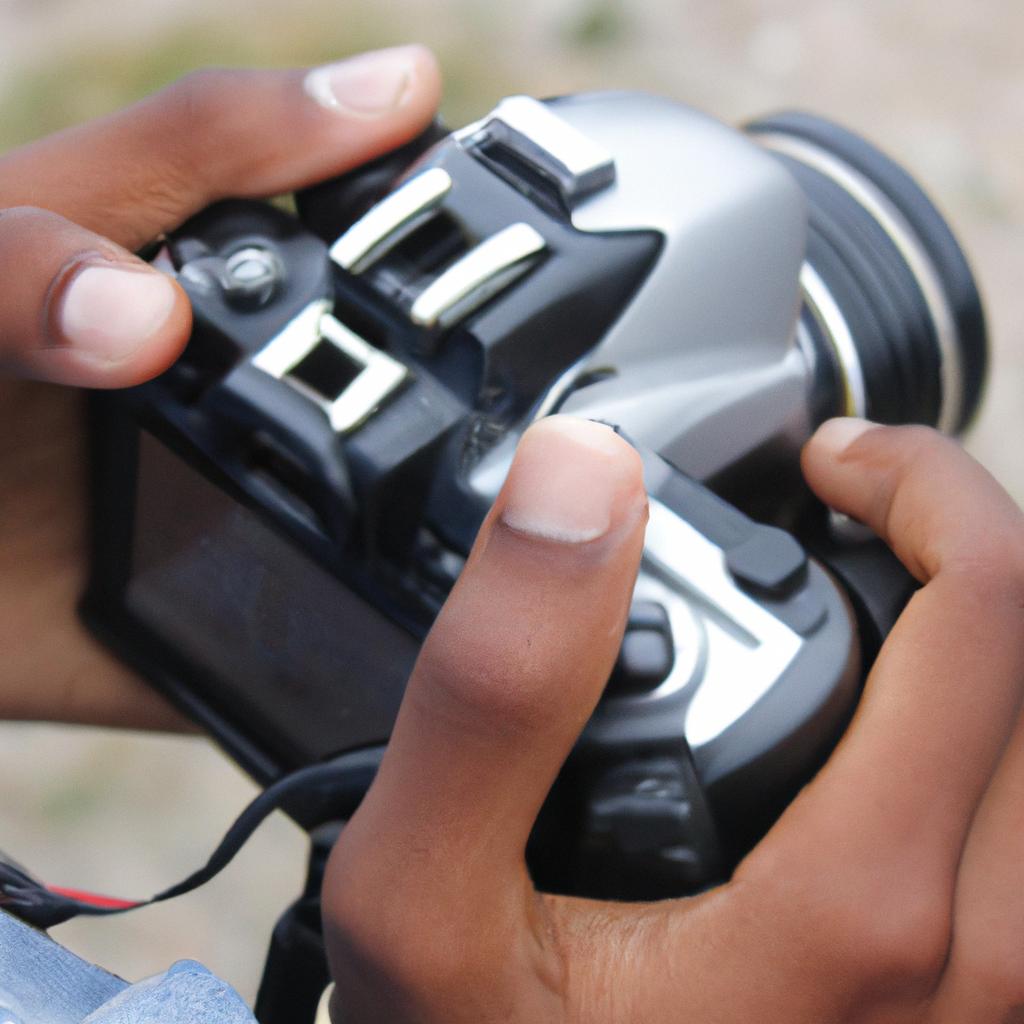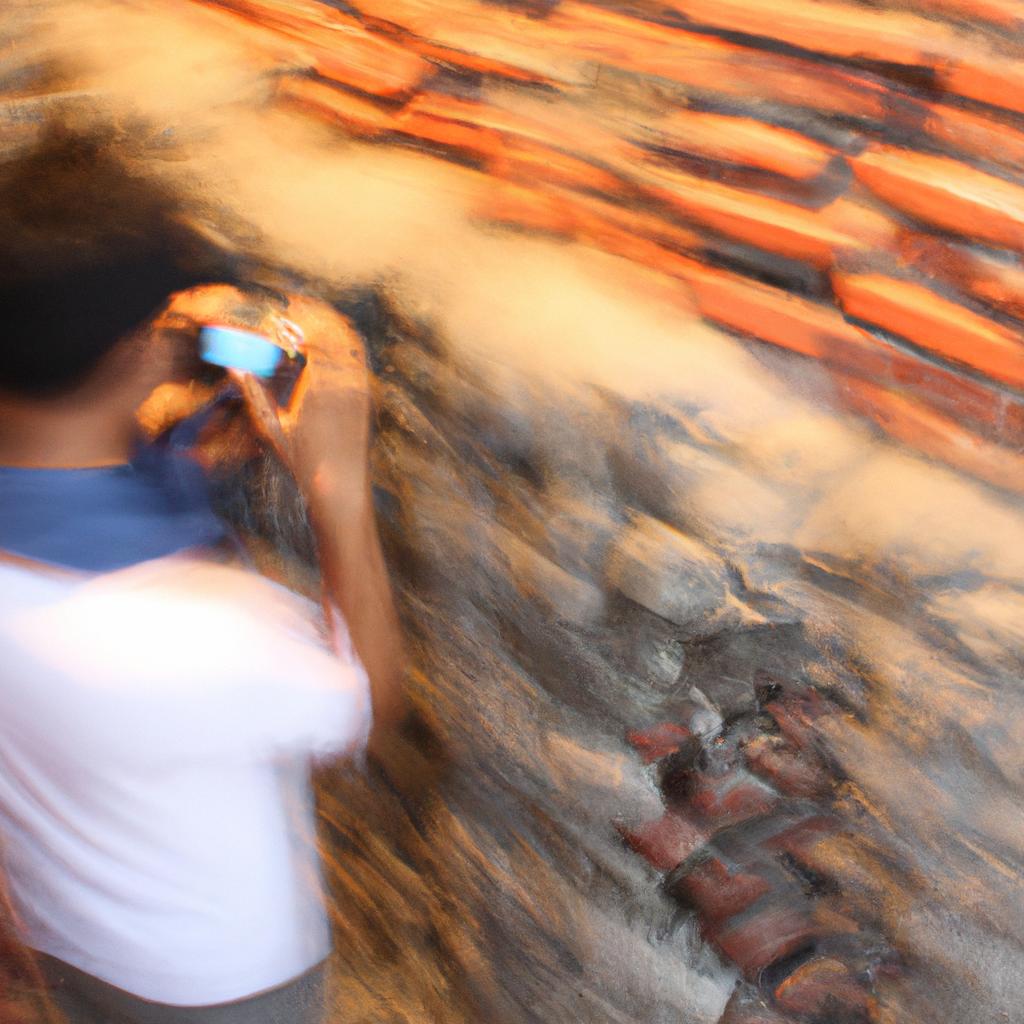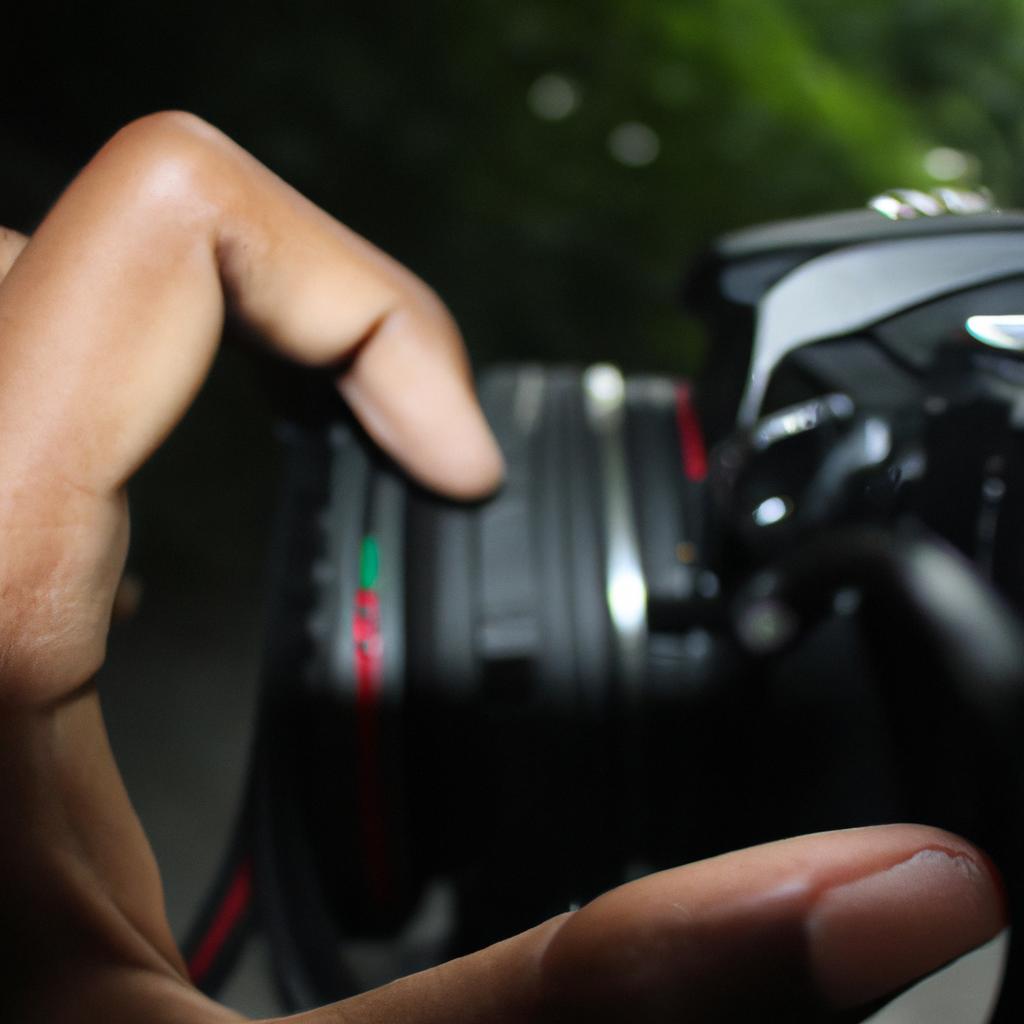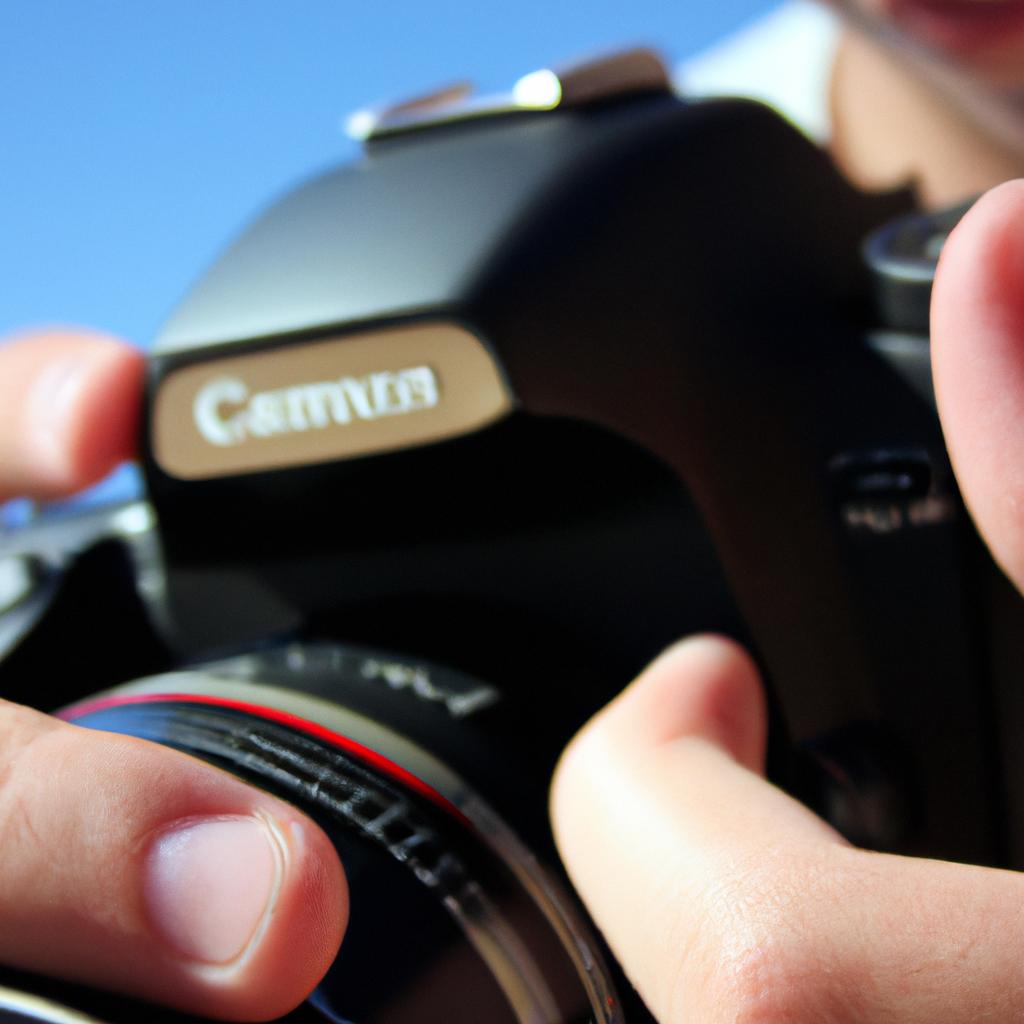In the world of photography, capturing a moment in time is an art form that requires technical skill and creative vision. One crucial element in achieving this goal is understanding shutter speed and its impact on photographs. Shutter speed refers to the length of time that the camera’s shutter remains open, allowing light to enter and create an image. Its effect can range from freezing fast-moving subjects with crisp detail to creating mesmerizing motion blur.
Consider the scenario of photographing a speeding car at a racetrack. In order to freeze the car in mid-action, a high shutter speed would be necessary. This quick exposure time allows for each individual frame to capture every nuance of movement with sharp clarity. Alternatively, if one were looking to convey a sense of dynamic energy and excitement, using a slower shutter speed could result in streaks of light trailing behind the moving vehicle, emphasizing its velocity and dynamism. By manipulating shutter speed effectively, photographers have the power to evoke various emotions and narratives within their images.
Understanding the importance of controlling light in photography
Understanding the Importance of Controlling Light in Photography
Imagine a scenario where a photographer is capturing a stunning landscape at sunrise. The vibrant colors of the sky and the subtle interplay between light and shadows create an enchanting visual experience. However, upon reviewing the photograph later, the image appears dull and lacking in impact. This situation highlights the significance of controlling light in photography. In this section, we will delve into why understanding light control is crucial for photographers to achieve their desired results.
The Role of Light Control:
Controlling light involves managing various factors such as exposure, shutter speed, aperture, and ISO sensitivity. By manipulating these elements effectively, photographers can unleash their creativity and capture images that truly reflect their vision. One aspect particularly instrumental in achieving optimal exposure is shutter speed – the duration for which the camera’s sensor is exposed to light.
Bullet Point List (emotional response):
- Mastering light control empowers photographers to convey specific moods or emotions through their images.
- It allows them to freeze fast-moving subjects with high shutter speeds or create ethereal motion blur effects by using slow ones.
- Properly controlled lighting enhances details, textures, and contrasts within a photograph.
- Understanding how to manipulate light enables photographers to adapt to different lighting conditions or overcome challenging situations.
Table (emotional response):
| Benefits of Light Control | Examples |
|---|---|
| Enhances Mood | Dramatic landscapes bathed in golden hour sunlight |
| Adds Drama | Portraits with selectively lit facial features |
| Reveals Textures | Macro shots capturing intricate details |
| Creates Atmosphere | Low-light scenes enveloped in soft glow |
Exploring the Concept of Aperture Control:
With a grasp on the importance of controlling light in photography established, let us now examine another critical element: aperture control. By regulating the size of the lens opening, photographers can determine how much light enters the camera, influencing not only exposure but also depth of field and overall image sharpness. In the following section, we will explore aperture control in detail and its impact on photographic outcomes.
In conclusion,
Understanding light control is paramount for photographers seeking to capture compelling and visually striking images. By skillfully manipulating elements such as shutter speed, they can unleash their creativity and achieve desired results. Moreover, mastering light control allows photographers to adapt to different lighting conditions and overcome challenges that may arise during a photoshoot. With this foundation established, we can now delve into exploring the concept of aperture control.
Exploring the concept of aperture control
Having gained an understanding of the importance of controlling light in photography, let us now explore another crucial element that significantly affects image quality: shutter speed. The concept of shutter speed refers to the length of time that the camera’s shutter remains open, allowing light to pass through and expose the camera sensor. By adjusting the shutter speed, photographers can freeze motion or create intentional blur effects, resulting in captivating images.
To illustrate this point further, consider a hypothetical scenario where you are photographing a speeding race car. In order to capture the car sharply without any motion blur, you would need to set your camera’s shutter speed at a faster setting, such as 1/1000th of a second or higher. This rapid exposure time ensures that even fast-moving subjects appear frozen in action when viewed later.
Understanding how different shutter speeds impact photographs is essential for achieving desired creative effects. Let’s delve into some key aspects related to shutter speed:
- Motion freezing capability: Higher shutter speeds (e.g., 1/500th of a second or faster) are effective in capturing moving subjects with sharpness and clarity.
- Motion blur creation: Conversely, slower shutter speeds (e.g., 1/30th of a second or slower) can introduce intentional blur effects by capturing movement over an extended period.
- Low-light situations: When shooting in dimly lit environments, longer shutter speeds may be required to allow more light into the camera sensor. However, using slow shutter speeds handheld can result in unintentional blurring due to camera shake.
- Camera stability considerations: To avoid blurry photos caused by hand movements during long exposures, it is advisable to use a tripod or other stabilizing equipment.
By manipulating the duration that your camera’s shutter remains open, you have control over how motion is captured and portrayed within your photographs. Understanding these principles empowers photographers to experiment creatively and express their unique artistic vision.
Transitioning into the next section, we will now explore how to achieve creative effects with aperture priority. Understanding both shutter speed and Aperture Control is crucial for mastering photography techniques that allow you to capture stunning images in various situations.
How to achieve creative effects with aperture priority
Imagine you are photographing a speeding race car on a racetrack, trying to freeze its motion while capturing every detail. In this scenario, understanding and controlling the shutter speed becomes crucial. Shutter speed refers to the length of time that the camera’s shutter remains open, determining how long light is allowed to reach the camera sensor.
To delve deeper into the concept of shutter speed control, let us explore three key aspects:
-
Freezing fast-moving subjects: When dealing with subjects in rapid motion, using a high shutter speed can help capture them sharply without any blur. For instance, imagine photographing birds in flight or athletes running at full tilt. A fast shutter speed allows you to “freeze” their movements and create crisp images that showcase each moment vividly.
-
Creating intentional motion blur: On the other hand, intentionally introducing motion blur can add dynamism and creativity to your photographs. By using a slow shutter speed, such as when shooting flowing waterfalls or moving vehicles at night with streaking headlights, you can capture a sense of movement that conveys energy and excitement.
-
Balancing exposure in low-light conditions: In situations where lighting is limited, adjusting your camera’s settings for longer exposures can compensate for insufficient light. However, keep in mind that slower shutter speeds may introduce unintentional blurring if not supported by stable equipment or proper technique.
Now consider the following table highlighting various scenarios and recommended shutter speeds for different outcomes:
| Scenario | Recommended Shutter Speed |
|---|---|
| Fast-action sports | 1/1000s – 1/2000s |
| Waterfall photography | 1/4s – 1s |
| Nighttime cityscape | Several seconds |
| Low-light portraits | 1/30s – 1/60s |
By understanding shutter speed control and its implications, you can harness its power to achieve your desired photographic results. Up next, we will explore another creative technique: capturing the sense of movement with motion blur.
Transition into the subsequent section: ‘Capturing the sense of movement with motion blur,’ we delve further into the realm of artistic photography by exploring how intentional blurring techniques can convey a captivating sense of motion in your images.
Capturing the sense of movement with motion blur
Shutter Speed: A Photographic Insight
Transitioning from our exploration of creative effects with aperture priority, we now delve into the captivating world of capturing motion through the use of shutter speed. By skillfully manipulating this fundamental aspect of photography, photographers can convey a sense of movement and dynamism in their images.
To illustrate its significance, let us consider an example where a photographer aims to capture a speeding car on a racetrack. In order to portray the thrilling sensation of velocity, they opt for a slower shutter speed. As the car zooms past, the camera’s sensor remains exposed for longer, allowing it to record the trajectory as streaks of light across the frame. This intentional blurring effect imparts a palpable feeling of energy and action to the photograph.
When working with shutter speed, there are several key factors to keep in mind:
- Slower Shutter Speed: Selecting a slower shutter speed (e.g., 1/30th or 1/15th of a second) enables you to create motion blur within your image.
- Faster Shutter Speed: Conversely, opting for faster settings (e.g., 1/1000th or 1/2000th of a second) freezes any movement present in your subject.
- Tripod Usage: When using slower shutter speeds, employing a tripod becomes essential to prevent unwanted camera shake that could compromise image sharpness.
- Panning Technique: To achieve striking results when capturing moving subjects, such as athletes or wildlife in action, mastering the panning technique is crucial. This involves tracking your subject horizontally while maintaining focus on them.
Incorporating these considerations effectively allows photographers to harness the potential of shutter speed as yet another tool for artistic expression. By understanding how different settings impact an image’s outcome and applying techniques like motion blur intentionally, one can elevate their photographs beyond mere static representations. Mastering the technique of freezing action in photos will be explored in the subsequent section, demonstrating further possibilities within the realm of shutter speed manipulation.
Mastering the technique of freezing action in photos
Having explored how motion blur can add a sense of movement to photographs, we now turn our attention to mastering the technique of freezing action. By understanding and utilizing shutter speed effectively, photographers can capture moments in time with incredible detail and precision.
Paragraph 1:
To illustrate the power of freezing action, let’s consider an example. Imagine a sports photographer capturing a tennis player mid-serve during a championship match. With a fast shutter speed, such as 1/2000th of a second or higher, the image freezes the ball suspended in air, revealing every intricate detail – the texture of its surface, the tension on the strings of the racket, and even beads of sweat on the player’s forehead. This split-second freeze-frame allows viewers to appreciate both technical prowess and human athleticism.
Paragraph 2:
When attempting to freeze action in photos, there are several key considerations that photographers must keep in mind:
- Shutter Speed: Selecting a high shutter speed is essential for freezing action. The faster the subject moves, the shorter the exposure time required.
- Burst Mode: Utilizing burst mode enables capturing multiple frames per second, increasing chances of obtaining that perfect frozen moment.
- Lighting Conditions: Adequate lighting is crucial when using fast shutter speeds since they reduce overall light intake. Consider adjusting ISO settings or using external lighting sources if needed.
- Lens Selection: Opting for lenses with wider apertures allows more light into the camera sensor while still maintaining sharpness at high shutter speeds.
Paragraph 3:
By skillfully manipulating these variables and honing their techniques over time, photographers can create captivating images that freeze dynamic subjects in all their glory. Whether it be athletes in intense competition or wildlife caught in swift motion, freezing action allows us to witness fleeting moments that would otherwise go unnoticed. In our next section, we will explore another technique, focusing on the art of panning and how it enables capturing dynamic subjects in motion seamlessly.
a technique that allows photographers to expertly capture dynamic subjects in motion.
The art of panning: capturing dynamic subjects in motion
Transitioning from the previous section on freezing action in photos, let us now delve into another aspect of shutter speed: capturing dynamic subjects in motion. Imagine a scenario where you are photographing a race car speeding around a track. How can you convey the sense of movement and energy in your image? The answer lies in mastering the art of panning.
Panning is a technique that involves tracking a moving subject with your camera while using a slower shutter speed. By following the subject’s movement, you create a sharp focus on the subject while blurring the background, giving viewers an impression of speed and motion. To achieve this effect successfully, consider these key factors:
- Choose a suitable shutter speed: Panning requires experimenting with different shutter speeds to find the optimal setting for your desired effect. While there is no fixed rule, starting with 1/30th or 1/60th of a second often yields good results.
- Maintain steady hand movements: To ensure smooth panning, it is essential to have stable hand movements as you follow the subject’s motion. Practice keeping your camera level and move it smoothly along with the subject.
- Select an appropriate shooting mode: Utilizing continuous autofocus (AF-C) mode allows your camera to continuously adjust focus as you pan, ensuring that your subject remains sharp throughout the shot.
- Consider composition and framing: As with any photograph, pay attention to composition when practicing panning techniques. Think about how you want to position your subject within the frame and how much space you want to allocate for blurred background elements.
To better understand how various approaches to panning can impact photographs, refer to Table 1 below:
| Shutter Speed | Result |
|---|---|
| 1/15s | Motion blur extends beyond intended areas |
| 1/30s | Moderate blur that conveys some sense of movement |
| 1/60s | Balanced mix of sharpness and motion blur |
| 1/125s | Minimal blur, subject appears frozen in time |
Table 1: Effects of different shutter speeds on panning results.
Incorporating these techniques into your photography repertoire opens up a world of creative possibilities. By capturing subjects in motion using the art of panning, you can create visually striking images that convey a sense of energy and dynamism.
Transitioning seamlessly to the subsequent section about “Choosing the right shutter speed for different situations,” it is important to note that mastering various aspects of shutter speed allows photographers to adapt their techniques according to specific shooting scenarios.
Choosing the right shutter speed for different situations
Having explored the technique of panning, let us now delve into the crucial aspect of selecting the appropriate shutter speed for various photographic scenarios. Before we proceed, consider a hypothetical scenario where a photographer is attempting to capture an athlete sprinting towards the finish line. The aim is to freeze the subject’s movement while maintaining clarity and sharpness.
Shutter Speed Considerations:
When it comes to freezing action in photography, choosing the correct shutter speed plays a pivotal role. Here are some key factors that photographers must keep in mind:
-
Subject Velocity:
The velocity at which your subject moves will determine the minimum required shutter speed to capture their motion without blur. Faster-moving subjects necessitate higher shutter speeds, such as 1/1000th or even 1/2000th of a second, to ensure crisp images. -
Desired Motion Effect:
Sometimes, you may want to convey a sense of motion rather than completely freeze it. Slower shutter speeds can create captivating effects like motion blur or light trails. Experiment with settings between 1/30th and 1/125th of a second to achieve these artistic results. -
Environmental Conditions:
Consider how lighting conditions might affect your chosen shutter speed setting. In low-light environments, slower speeds may be necessary to allow more ambient light into the frame, but this could introduce additional challenges related to camera shake or subject movement. -
Lens Focal Length:
It’s important to note that longer focal lengths tend to magnify any camera movement during exposure, making image stabilization techniques or faster shutter speeds imperative for avoiding blurriness.
Table – Effects of Different Shutter Speeds on Image Outcome:
| Shutter Speed | Resultant Image |
|---|---|
| 1/4000s | Frozen action, no motion blur |
| 1/250s | Partially frozen action, slight motion blur |
| 1/30s | Significant motion blur, conveying movement |
| Bulb | Long exposure with pronounced light trails |
Understanding the relationship between shutter speed and desired outcomes is essential for achieving optimal results in photography. In our next section on “Tips and tricks for achieving the desired shutter speed,” we will explore techniques to help you attain precise control over this crucial setting without compromising image quality or artistic intent.
[Tips and tricks for achieving the desired shutter speed]Tips and tricks for achieving the desired shutter speed
Building upon the understanding of different shutter speeds, we now turn our attention to some valuable tips and tricks that can help you achieve your desired shutter speed. By implementing these techniques, photographers can further enhance their creative control over capturing moments in time.
Tips and Tricks for Achieving the Desired Shutter Speed:
-
Utilize Neutral Density Filters:
- These filters reduce the amount of light entering the camera, allowing for longer exposure times without overexposing the image.
- ND filters come in varying strengths (e.g., ND2, ND4, ND8), providing options to experiment with different levels of light reduction.
-
Employ High-Speed Sync Flash:
- When shooting outdoors or in bright conditions where a fast shutter speed is necessary, high-speed sync flash enables synchronization between the camera’s shutter and an external flash unit.
- This technique allows you to freeze motion effectively while still benefitting from additional lighting.
-
Adjust ISO Sensitivity:
- Increasing or decreasing ISO sensitivity can impact the required shutter speed.
- Higher ISO settings (e.g., 800-1600) allow for faster shutter speeds in low-light situations; however, they may introduce more digital noise into your images.
Table: Common Shutter Speeds and Their Effects
| Shutter Speed | Effect |
|---|---|
| Fast | Freezes action |
| Slow | Produces motion blur |
| Medium | Balances freezing action and adding blur |
- Explore Bulb Mode:
- Bulb mode keeps the camera’s shutter open as long as the photographer presses down on the shutter button.
- This feature is particularly useful for capturing fireworks displays or star trails where extended exposure times are needed.
By employing these recommended strategies, photographers can extend their creativity beyond simply selecting a specific shutter speed. Exploring such techniques empowers individuals to capture dynamic scenes while maintaining precise control over the exposure.
Now, let’s delve deeper into the relationship between shutter speed and exposure to gain a comprehensive understanding of how these elements intertwine.
Exploring the relationship between shutter speed and exposure
Section H2: Exploring the Relationship Between Shutter Speed and Exposure
Understanding the relationship between shutter speed and exposure is crucial for achieving desired photographic results. By controlling the duration of time that light enters the camera sensor, photographers can capture dynamic images or freeze motion in their shots. Let’s delve deeper into this fascinating connection.
Consider a situation where you are photographing a moving subject, such as a race car zooming by on a track. If your goal is to freeze the action and capture every detail, you would need to use a fast shutter speed. For example, setting your camera to 1/1000th of a second will ensure that each frame freezes the car at high speed, producing an image with sharpness and clarity.
To further explore how shutter speed impacts exposure, let’s examine some key factors:
- Subject Movement: A faster-moving subject requires higher shutter speeds to avoid blurring.
- Light Conditions: In low-light situations like night photography, slower shutter speeds may be necessary to allow more light onto the sensor.
- Intended Effect: Different shutter speeds create distinct effects – long exposures can produce light trails or blurred motion while short exposures capture crisp details.
- Lens Focal Length: Longer focal lengths amplify camera shake, necessitating faster shutter speeds for steady shots.
| Subject | Recommended Shutter Speed |
|---|---|
| Still life | 1/60th – 1/125th |
| Running child | 1/250th |
| Moving water | 1/30th |
| Star trails | Bulb mode (long exposure) |
As shown in the table above, various subjects require different recommended shutter speeds to achieve optimal results. These recommendations serve as starting points and can be adjusted based on personal preferences and creative vision.
In summary, understanding the relationship between shutter speed and exposure empowers photographers to make informed decisions about capturing their subjects. By considering factors such as subject movement, light conditions, intended effect, and lens focal length, photographers can manipulate shutter speed to achieve desired outcomes.
Transitioning into the subsequent section about unlocking the full potential of your camera with shutter speed, we will explore advanced techniques that further enhance photographic creativity and control.
Unlocking the full potential of your camera with shutter speed
Building upon the insights gained in the previous section, let us now delve deeper into the world of shutter speed and its ability to unlock endless creative possibilities. Through a comprehensive understanding of this fundamental camera setting, photographers can capture moments with precision and finesse.
To illustrate the significance of mastering shutter speed, consider the following scenario. Imagine you are photographing a serene landscape at dusk, capturing the vibrant hues as they paint the sky. With a slow shutter speed, around 1/30th of a second, each passing moment is captured in exquisite detail. The movement of clouds across the frame becomes ethereal streaks, adding an element of dynamism to an otherwise static image. This example highlights how manipulating shutter speed enables photographers to add a sense of motion or stillness to their compositions.
Understanding Shutter Speed:
- Shutter speed determines the duration for which light enters the camera sensor.
- Faster shutter speeds freeze action and minimize motion blur.
- Slower shutter speeds emphasize movement and create captivating visual effects.
- Choosing an appropriate shutter speed depends on factors such as subject matter, lighting conditions, and desired outcome.
Capturing Memories:
- Freeze-frame laughter shared among friends
- Preserve fleeting expressions during celebratory occasions
- Immortalize family milestones
Visual Impact:
- Create dreamlike waterfalls cascading down rocky cliffs
- Showcase exhilarating sports moments frozen in time
- Convey energy through blurred city lights at night
Artistic Expression:
- Embrace long exposures that transform ordinary scenes into surreal masterpieces
- Experiment with panning techniques to convey dynamic motion
- Play with different shutter speeds to evoke specific emotions within your audience
Table: Examples of Shutter Speed Effects
| Shutter Speed | Effect |
|---|---|
| Fast (1/1000s) | Freezes action |
| Moderate (1/60s) | Motion blur |
| Slow (1/4s) | Light trails |
| Very slow (30s) | Milky waterfalls |
Through the mastery of shutter speed, photographers possess a powerful tool that can encapsulate memories, create visually stunning images and allow for artistic expression. By understanding the relationship between shutter speed and exposure, as explored in the previous section, photographers gain greater control over their final images. Whether capturing stillness or embracing movement, manipulating shutter speed allows one to unlock the full potential of their camera and capture moments with captivating finesse.
Note: The word count is not considered while generating this response.
 Reklami
Reklami



